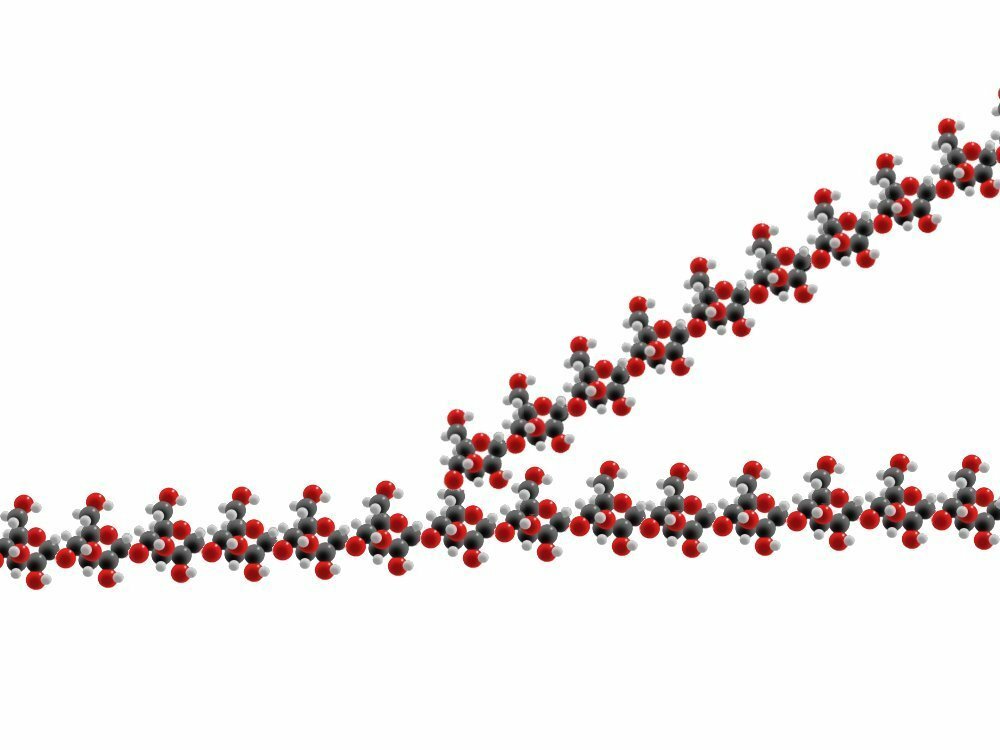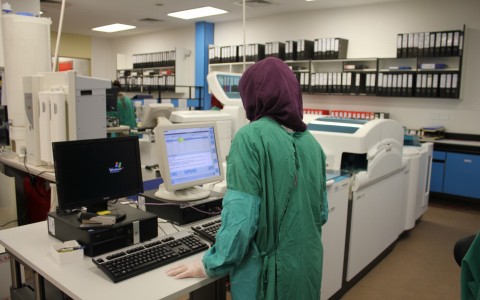|
Glycogen Branching Enzyme Deficiency
Glycogen-branching enzyme deficiency (GBED) is an inheritable glycogen storage disease affecting American Quarter Horses and American Paint Horses. It leads to abortion, stillbirths, or early death of affected animals. The human form of the disease is known as glycogen storage disease type IV. Pathophysiology Glycogen is a molecular polymer of glucose used to store energy. It is important for providing energy for skeletal and cardiac muscle contraction, and for maintaining glucose hemostasis in the blood. Molecules of glucose are linked into linear chains by α-1,4-glycosidic bonds. Additionally, branches of glucose are formed off of the chain via α-1,6-glycosidic bonds. 2 molecules of glucose are joined into an α-1,4-glycosidic bonds by an enzyme known as glycogen synthase. This bond may be broken by amylase when the body wishes to break down glycogen into glucose for energy. Glycogen branching enzyme is responsible for the required α-1,6-glycosidic bonds needed to start a bra ... [...More Info...] [...Related Items...] OR: [Wikipedia] [Google] [Baidu] |
Glycogen Storage Disease
A glycogen storage disease (GSD, also glycogenosis and dextrinosis) is a metabolic disorder caused by a deficiency of an enzyme or transport protein affecting glycogen synthesis, glycogen breakdown, or glycolysis, glucose breakdown, typically in muscles and/or liver cells. GSD has two classes of cause: genetic and environmental. Genetic GSD is caused by any Inborn errors of carbohydrate metabolism, inborn error of carbohydrate metabolism (genetically defective enzymes or transport proteins) involved in these processes. In livestock, environmental GSD is caused by Substance intoxication, intoxication with the alkaloid castanospermine. However, not every inborn error of carbohydrate metabolism has been assigned a GSD number, even if it is known to affect the muscles or liver. For example, phosphoglycerate kinase deficiency (gene PGK1) has a myopathic form. Also, Fanconi–Bickel syndrome, Fanconi-Bickel syndrome (gene SLC2A2) and Danon disease (gene LAMP2) were declassed as GSDs d ... [...More Info...] [...Related Items...] OR: [Wikipedia] [Google] [Baidu] |
Autosomal Recessive
In genetics, dominance is the phenomenon of one variant (allele) of a gene on a chromosome masking or overriding the Phenotype, effect of a different variant of the same gene on Homologous chromosome, the other copy of the chromosome. The first variant is termed dominant and the second is called recessive. This state of having Heterozygosity, two different variants of the same gene on each chromosome is originally caused by a mutation in one of the genes, either new (''de novo'') or Heredity, inherited. The terms autosomal dominant or autosomal recessive are used to describe gene variants on non-sex chromosomes (autosomes) and their associated traits, while those on sex chromosomes (allosomes) are termed X-linked dominant, X-linked recessive or Y-linked; these have an inheritance and presentation pattern that depends on the sex of both the parent and the child (see Sex linkage). Since there is only one Y chromosome, Y-linked traits cannot be dominant or recessive. Additionally, ... [...More Info...] [...Related Items...] OR: [Wikipedia] [Google] [Baidu] |
King (horse)
King (1932–1958), often known as King P-234, was an outstanding early Quarter Horse stallion who influenced the breed throughout the early years of the American Quarter Horse Association (or AQHA). Life King was born June 25, 1932, the offspring of Zantanon and Jabalina.Holmes ''King P-234'' p. 38 Originally named Buttons by his breeder,Volpe "Breeder of King P-234" ''The Cattleman'' pp. 105–107 he was renamed King when he was registered with the AQHA as number 234. He was a bay stallion, bred by Manuel Benavides Volpe of Laredo, Texas, and owned at the time of registration by Jess L. Hankins of Rocksprings, Texas.AQHA ''Official Stud Book and Registry Combined 1–5'' p. 86 The AQHA gave his sire as Zantanon by Little Joe by Traveler and his dam as Jabalina by Strait Horse by Yellow Jacket by Little Rondo (Bunton Horse). His second dam was a mare by Traveler, making him linebred to Traveler. [...More Info...] [...Related Items...] OR: [Wikipedia] [Google] [Baidu] |
Selective Breeding
Selective breeding (also called artificial selection) is the process by which humans use animal breeding and plant breeding to selectively develop particular phenotypic traits (characteristics) by choosing which typically animal or plant males and females will sexually reproduce and have offspring together. Domesticated animals are known as breeds, normally bred by a professional breeder, while domesticated plants are known as varieties, cultigens, cultivars, or breeds. Two purebred animals of different breeds produce a crossbreed, and crossbred plants are called hybrids. Flowers, vegetables and fruit-trees may be bred by amateurs and commercial or non-commercial professionals: major crops are usually the provenance of the professionals. In animal breeding artificial selection is often combined with techniques such as inbreeding, linebreeding, and outcrossing. In plant breeding, similar methods are used. Charles Darwin discussed how selective breeding had been succ ... [...More Info...] [...Related Items...] OR: [Wikipedia] [Google] [Baidu] |
UC Davis
The University of California, Davis (UC Davis, UCD, or Davis) is a Public university, public Land-grant university, land-grant research university in Davis, California, United States. It is the northernmost of the ten campuses of the University of California system. The institution was first founded as an Agriculture, agricultural branch of the system in 1905 and became the sixth campus of the University of California in 1959. Founded as a primarily agricultural campus, the university has expanded over the past century to include graduate and professional programs in UC Davis School of Medicine, medicine (which includes the UC Davis Medical Center), UC Davis College of Engineering, engineering, UC Davis College of Letters and Science, science, UC Davis School of Law, law, UC Davis School of Veterinary Medicine, veterinary medicine, UC Davis School of Education, education, Betty Irene Moore School of Nursing, nursing, and UC Davis Graduate School of Management, business managemen ... [...More Info...] [...Related Items...] OR: [Wikipedia] [Google] [Baidu] |
University Of Minnesota
The University of Minnesota Twin Cities (historically known as University of Minnesota) is a public university, public Land-grant university, land-grant research university in the Minneapolis–Saint Paul, Twin Cities of Minneapolis and Saint Paul, Minnesota, United States. It is the Flagship#Colleges and universities in the United States, flagship institution of the University of Minnesota System and is organized into 19 colleges, schools, and other major academic units. The Twin Cities campus is the oldest and largest in the University of Minnesota system and has the List of United States university campuses by enrollment, ninth-largest (as of the 2022–2023 academic year) main campus student body in the United States, with 54,890 students at the start of the 2023–24 academic year. The campus comprises locations in Minneapolis and Falcon Heights, Minnesota, Falcon Heights, a suburb of St. Paul, approximately apart. The Minnesota Territorial Legislature drafted a charter ... [...More Info...] [...Related Items...] OR: [Wikipedia] [Google] [Baidu] |
Blood Test
A blood test is a medical laboratory, laboratory analysis performed on a blood sample that is usually extracted from a vein in the arm using a hypodermic needle, or via fingerprick. Multiple tests for specific blood components, such as a glucose test or a cholesterol test, are often grouped together into one test panel called a blood panel or blood work. Blood tests are often used in health care to determine physiological and biochemical states, such as disease, mineral content, pharmaceutical drug effectiveness, and organ function. Typical medicine#Clinical practice, clinical blood panels include a basic metabolic panel or a complete blood count. Blood tests are also used in drug tests to detect drug abuse. Extraction A venipuncture is useful as it is a Invasiveness of surgical procedures, minimally invasive way to obtain cell (biology), cells and extracellular fluid (blood plasma, plasma) from the body for analysis. Blood flows throughout the body, acting as a medium that prov ... [...More Info...] [...Related Items...] OR: [Wikipedia] [Google] [Baidu] |
Heterozygous
Zygosity (the noun, zygote, is from the Greek "yoked," from "yoke") () is the degree to which both copies of a chromosome or gene have the same genetic sequence. In other words, it is the degree of similarity of the alleles in an organism. Most eukaryotes have two matching sets of chromosomes; that is, they are diploid. Diploid organisms have the same locus (genetics), loci on each of their two sets of homologous chromosomes except that the sequences at these loci may differ between the two chromosomes in a matching pair and that a few chromosomes may be mismatched as part of a chromosomal Sex-determination system#Chromosomal determination, sex-determination system. If both alleles of a diploid organism are the same, the organism is #Homozygous, homozygous at that locus. If they are different, the organism is #Heterozygous, heterozygous at that locus. If one allele is missing, it is #Hemizygous, hemizygous, and, if both alleles are missing, it is #Nullizygous, nullizygous. The ... [...More Info...] [...Related Items...] OR: [Wikipedia] [Google] [Baidu] |
Phenotype
In genetics, the phenotype () is the set of observable characteristics or traits of an organism. The term covers the organism's morphology (physical form and structure), its developmental processes, its biochemical and physiological properties, and its behavior. An organism's phenotype results from two basic factors: the expression of an organism's genetic code (its genotype) and the influence of environmental factors. Both factors may interact, further affecting the phenotype. When two or more clearly different phenotypes exist in the same population of a species, the species is called polymorphic. A well-documented example of polymorphism is Labrador Retriever coloring; while the coat color depends on many genes, it is clearly seen in the environment as yellow, black, and brown. Richard Dawkins in 1978 and again in his 1982 book '' The Extended Phenotype'' suggested that one can regard bird nests and other built structures such as caddisfly larva cases and beaver dams ... [...More Info...] [...Related Items...] OR: [Wikipedia] [Google] [Baidu] |
Hypoglycemic
Hypoglycemia (American English), also spelled hypoglycaemia or hypoglycæmia (British English), sometimes called low blood sugar, is a fall in blood sugar to levels below normal, typically below 70 mg/dL (3.9 mmol/L). Whipple's triad is used to properly identify hypoglycemic episodes. It is defined as blood glucose below 70 mg/dL (3.9 mmol/L), symptoms associated with hypoglycemia, and resolution of symptoms when blood sugar returns to normal. Hypoglycemia may result in headache, tiredness, clumsiness, trouble talking, confusion, fast heart rate, sweating, shakiness, nervousness, hunger, loss of consciousness, seizures, or death. Symptoms typically come on quickly. Symptoms can remain even soon after raised blood level. The most common cause of hypoglycemia is medications used to treat diabetes such as insulin, sulfonylureas, and biguanides. Risk is greater in diabetics who have eaten less than usual, recently exercised, or consumed alcohol. Other causes ... [...More Info...] [...Related Items...] OR: [Wikipedia] [Google] [Baidu] |
Glycogen Branching Enzyme
1,4-alpha-glucan-branching enzyme, also known as brancher enzyme or glycogen-branching enzyme is an enzyme that in humans is encoded by the ''GBE1'' gene. Glycogen branching enzyme is an enzyme that adds branches to the growing glycogen molecule during the synthesis of glycogen, a storage form of glucose. More specifically, during glycogen synthesis, a glucose 1-phosphate molecule reacts with uridine triphosphate (UTP) to become UDP-glucose, an activated form of glucose. The activated glucosyl unit of UDP-glucose is then transferred to the hydroxyl group at the C-4 of a terminal residue of glycogen to form an α-1,4-glycosidic linkage, a reaction catalyzed by glycogen synthase. Importantly, glycogen synthase can only catalyze the synthesis of α-1,4-glycosidic linkages. Since glycogen is a readily mobilized storage form of glucose, the extended glycogen polymer is branched by glycogen branching enzyme to provide glycogen breakdown enzymes, such as glycogen phosphorylase, with ma ... [...More Info...] [...Related Items...] OR: [Wikipedia] [Google] [Baidu] |









